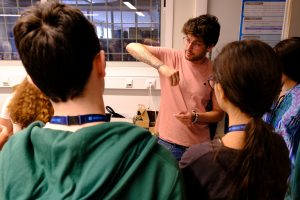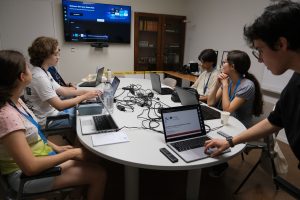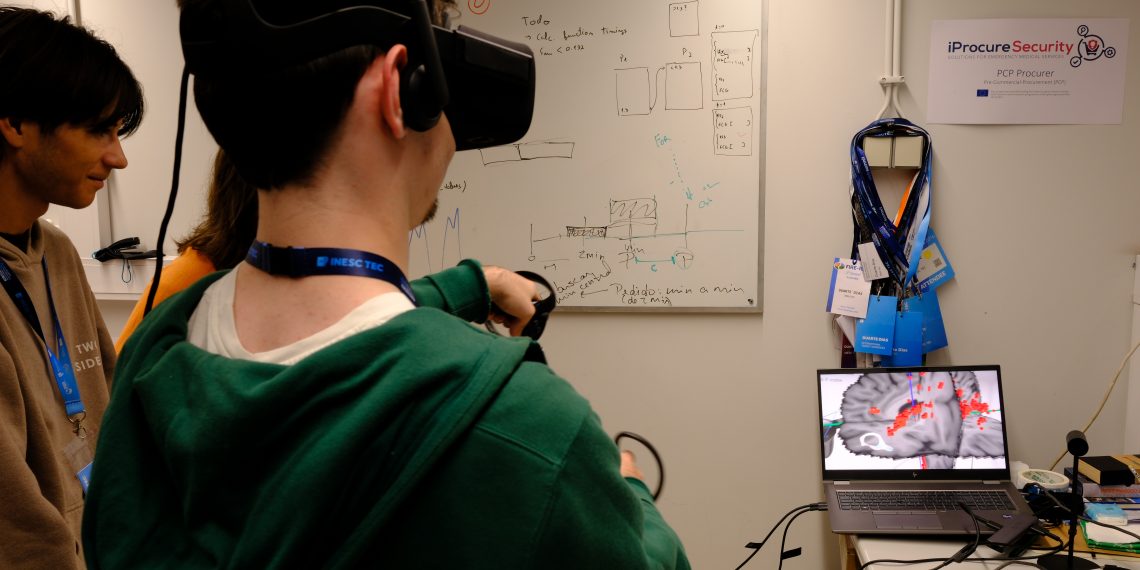Five high school students headed to INESC TEC, determined to explore science and engineering to transform and revolutionise healthcare. This was the premise of the 29th edition of the Ciência Viva no Laboratório – Ocupação Científica de Jovens nas Férias 2025 initiative, which took place between July 7 and 11, at INESC TEC. The initiative, promoted by Ciência Viva, offers students from across the country the chance to experience the day-to-day reality of scientific research and innovation in a real-world setting.
This year’s group was challenged to answer the question “how are science and engineering revolutionising healthcare?”, mainly by exploring the work developed by INESC TEC in Artificial Intelligence, Telecommunications and Multimedia, and Biomedical Engineering. Over the course of a week, through hands-on activities, talks, and exploration of technologies and tools – always side by side with researchers – the students were introduced to the world of science and technology and came to understand how this work influences society.

Artificial Intelligence in healthcare
The young scientists’ journey began with an innovative approach to healthcare, with Artificial Intelligence (AI) in medical processes, e.g., image diagnosis, personalised medicine, or clinical decision support – the session was conducted by Miriam Seoane Santos. On this day, they explored how information retrieval tools work, using AI algorithms and language models to understand different ways of supporting clinical staff in researching similar cases to aid their decision-making.
Medical imaging and neural networks
How do computers interpret images or recognise objects? How can we use data gathered by AI to extract useful knowledge? These were some of the questions explored on the day dedicated to computer vision and the potential of machines to support professionals in the healthcare sector. Daniela Santos, a Telecommunications researcher at INESC TEC and one of the mentors on this topic, said “it was incredibly rewarding to witness the students’ enthusiasm and curiosity, especially given how young they are. The dynamic throughout the week was excellent, and it was a pleasure to share knowledge and show them some of the many future possibilities that science and technology have to offer.” In short, “the experience exceeded all expectations.”

Biomedical CSI
Simple everyday objects, when equipped with sensors, can now monitor human activity, detect health issues, simplify hospital monitoring, or even anticipate critical episodes. The student explored and tested innovative applications, many of which are already under study in laboratory settings. “The students had the opportunity, on one hand, to explore some of the wearables we’ve developed and visit our labs, and on the other, to explore various sensors outdoors in a practical activity, understanding how these devices can provide us with important information about our bodies,” explained Rita Vieira and Duarte Carvalho, INESC TEC researchers in Biomedical Engineering. Regarding the group’s involvement, the researchers were clear: “the students managed to come up with a creative project in the field of biomedical sensors, already showing critical thinking and a significant interest in research.”
The final challenge
At the end of the internship, and based on everything they had learned, the students were given the opportunity to prepare and present a project they believed could help improve healthcare procedures in the future. They called it “Oral Scan” – an innovative technology aimed at tackling oral health issues in Portugal. They created a toothbrush equipped with sensors capable of collecting biological data to detect diseases like cancer or even anticipate more common health concerns, such as diabetes. During the project, they also developed a dedicated website, identified potential strategic partners, and combined ideas for promoting the technology and defining commercialisation strategies. The project was presented to a panel of evaluators on the final day of the internship, where they received feedback on technological feasibility and business potential.

Ana Filipa Sequeira, a researcher at INESC TEC in Telecommunications and one of the jurors, said: “It’s always a pleasure to be involved in Ciência Viva activities at INESC TEC. Throughout the week, the students had countless opportunities to learn new things, and I was pleasantly surprised by the project they presented; they boldly and ambitiously applied much of the new knowledge they had gained.”
Sara Brandão, head of the Student Research Office and part of the evaluation panel, highlighted the work carried out over the week: “It’s impressive to witness what these students were able to develop in such a short time – with creativity, critical thinking, and genuine enthusiasm. Watching these young people apply new knowledge and propose real solutions to real challenges demonstrates the immense potential that exists when we open the doors of science.” Aligned with the mission of the Student Research Office – “to enrich the research journey of INESC TEC students and connect them to the scientific and business ecosystem” – this initiative proves to be highly valuable. “We need more opportunities like this, which connect research with society and sow the seeds of science early on.”
Ciência Viva no Laboratório is a summer internship programme for students from the 9th to the 12th degree; it offers young people the opportunity to take part in free internships at national scientific institutions. The programme aims to promote hands-on science education and encourage young people to pursue careers in science.
The researchers mentioned in this news piece are associated with INESC TEC.



 News, current topics, curiosities and so much more about INESC TEC and its community!
News, current topics, curiosities and so much more about INESC TEC and its community!